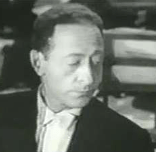PLATTER PERSPECTIVE: Violinist Jascha Heifetz
 by Peter Cates
by Peter Cates
Jascha Heifetz
Violinist Jascha Heifetz (1901-1987) held a series of televised master classes at UCLA in 1962; I recently watched the first one on YouTube and was quite fascinated by his personality and teaching style for its entire 1 hour.
He had a half dozen students sitting with what seemed to be a combination of fear and anticipation and, by stating that he promises not to perform himself, provoked relaxed laughter. During the first hour, only two would play while his longtime accompanist Brooks Smith (1912-2000) served as pianist .
The first student performed a short piece by the 19th century virtuoso/composer Wienawski. Heifetz would listen, telling the student to phrase with more expression, to speed up the tempo in order to sustain the rhythmic excitement or to slow down. At times, he would play a passage from memory to demonstrate what he wanted from the student. At other moments, he would be following his own score with a pencil, silently beating time.
The second student was Erick Friedmann (1939-2004) who would record Bach’s Concerto for Two Violins with Heifetz for RCA Victor around the same time and who became his most well-known protégé. He played sections of the Brahms Violin Concerto while Heifetz listened with at times smiling admiration and then joined Friedmann for the last movement of the previously mentioned Bach.
When Heifetz, at the age of 11, gave a private recital at a home in Berlin in 1912, Fritz Kreisler commented that “we might as well take our fiddles and break them across our knees.”
For hobbies, Heifetz collected books and stamps, played tennis and ping pong and would go sailing off the coast of Southern California. He routinely practiced three to four hours and advised his students against both practicing too much and practicing too little.
When Heifetz recorded the Brahms Violin Concerto in 1955 with Fritz Reiner and the Chicago Symphony, RCA producer Richard Mohr asked the violinist if he was ready to begin the session, he replied, “No, I am not ready, I will never be ready, but we might as well get this over with.” The usually stern Reiner almost broke out giggling.
Along with the 1955 Brahms Concerto, I highly recommend the 1935 Sibelius Violin Concerto collaboration with Sir Thomas Beecham and the Royal Philharmonic; the 1940 Beethoven Concerto with Arturo Toscanini and the NBC Symphony and, again with Reiner/Chicago, the 1957 Tchaikovsky Concerto, all the above and so much else of Heifetz available on YouTube.
Itzhak Perlman paid tribute once by commenting that Heifetz could do things on the violin that were impossible for all of the other violinists. Heifetz’s perfection was often equated with that of God.
Responsible journalism is hard work!
It is also expensive!
If you enjoy reading The Town Line and the good news we bring you each week, would you consider a donation to help us continue the work we’re doing?
The Town Line is a 501(c)(3) nonprofit private foundation, and all donations are tax deductible under the Internal Revenue Service code.
To help, please visit our online donation page or mail a check payable to The Town Line, PO Box 89, South China, ME 04358. Your contribution is appreciated!



Heifetz was called “God’s fiddler” for a reason. Besides Friedman, Heifetz only recorded with one other violinist – as far as I know – and that was Israel Baker.